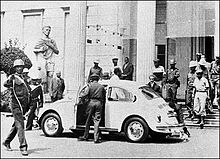Ethiopian Student Movement
 From Wikipedia the free encyclopedia
From Wikipedia the free encyclopedia
| Ethiopian Student Movement | |||
|---|---|---|---|
| Part of Opposition to Haile Selassie | |||
 Public demonstration amid the Ethiopian Revolution in 1974 | |||
| Date | 1960–1974 | ||
| Location | |||
| Caused by |
| ||
| Goals |
| ||
| Methods | |||
| Resulted in |
| ||
| Parties | |||
| |||
| Lead figures | |||
| Casualties | |||
| Death(s) | 30,000–750,000 (estimates vary widely)[1] | ||
The Ethiopian Student Movement (Amharic: የኢትዮጵያ ተማሪዎች ንቅንቄ, ESM) was a period of radical Marxist–Leninist student activism and movement in Ethiopia from the mid-1960s to the 1974 revolution. The first demonstration occurred in 1965 by university student, led by Marxist–Leninist motivation chanting "Land to the Tiller" and "Is poverty a crime?". The student uprisings continued in 1966 until 1969. The movement also called for the abolish of monarchy under Emperor Haile Selassie and feudalism in Ethiopia.
Following the 1974 revolution, the ESM members in Ethiopia and aboard superintended many political organizations like the Ethiopian People's Revolutionary Party (EPRP) and All-Ethiopia Socialist Movement (MEISON), that involved in insurgency against the Derg regime. Scholars agreed that the ESM has laid foundation of many opposition forces behind the Derg government during the Ethiopian Civil War, especially the Tigray People's Liberation Front (TPLF) and the inspired the EPRDF's notion of "multi-nation, multi-ethnic, and multilingual nature of Ethiopia". As such, ESM is critical for the 21st-century Ethiopian ethnic conflict.[2][3]
History[edit]
The first demonstration occurred in 1965 driven by Marxist–Leninist university students with the slogan "Land to the Tiller".[2][4] It was followed by the 1966, 1967 and 1968 uprising with "the powers that be on a variety of social and political issues". In May 1966, the student confronted the police, chanting the slogan "Is poverty a crime?".[5]
In April 1967, the third successive year of protest occurred near Arat Kilo campus rather than Siddest Kilo campus. In response, the Ethiopian government issued law to Ministry of Interior that restrict the protest. Two days prior, about 1,500 and 1,700 people demonstrated in Arat Kilo campus but were deterred by police force, utilizing tear gas and began attacking the demonstrator. The 1973 nationwide famine also agitated the student activism and protest. Elleni Zeleke wrote:[6][7]
"The very spontaneity of the popular movements of 1974 also meant that the various [student] groups involved were not able to develop their own organization and political leadership before the soldiers pushed forward to monopolize power."
Legacy[edit]

The Ethiopian Student Movement was crucial for the fall of Emperor Haile Selassie regime, the 1974 revolution and the seizure of Derg military junta.[2] Many political parties during the Derg era emerged from ESM, mostly the Ethiopian People's Revolutionary Party (EPRP) which was formed by students that exiled to the United States, Europe and Algiers while the All-Ethiopia Socialist Movement (MEISON) came out from the Ethiopian Student Union in Europe (ESUE).[8] The Derg also proposed prerequisites for ESM student demands, such as land reform and the creation of peasant association. The Tigray People's Liberation Front (TPLF) and the Ethiopian People's Revolutionary Democratic Front (EPRDF) whose formation traced back after the 1974 revolution, also inspired the main ESM ideologues of debate of "multi-nation, multi-ethnic, and multilingual nature of Ethiopia".[9] Hannah Borenstein, who backed Bahru Zewde opinion, wrote that the 1969 student activism was both good and bad, and bequeathed to the contemporary ethnic conflict in Ethiopia.[10]
Notable leaders[edit]

References[edit]
- ^ "The Legacies of the Ethiopian Student Movement". Jacobin. Retrieved 10 March 2024.
- ^ a b c Lemma, Legesse (1979). "The Ethiopian Student Movement 1960-1974: A Challenge to the Monarchy and Imperialism in Ethiopia". Northeast African Studies. 1 (2): 31–46. ISSN 0740-9133.
- ^ Adamu, Abebaw Yirga; Balsvik, Randi Rønning (2018), Oinas, Elina; Onodera, Henri; Suurpää, Leena (eds.), "Students' Participation in and Contribution to Political and Social Change in Ethiopia", What Politics?, Youth and Political Engagement in Africa, vol. 6, Brill, pp. 265–284, doi:10.1163/j.ctvbqs5zx.22?seq=1, retrieved 2024-03-09
- ^ "African Books Collective: Documenting the Ethiopian Student Movement". www.africanbookscollective.com. Retrieved 2024-03-09.
- ^ Talton, Benjamin (2019-08-23). In This Land of Plenty: Mickey Leland and Africa in American Politics. University of Pennsylvania Press. ISBN 978-0-8122-5147-0.
- ^ Abdalla, Ahmed (2008). The Student Movement and National Politics in Egypt, 1923-1973. American Univ in Cairo Press. ISBN 978-977-416-199-5.
- ^ "(Historical Materialism Book) Elleni Centime Zeleke - Ethiopia in Theory - Revolution and Knowledge Production, 1964-2016-Brill Academic Pub (2019) | PDF | Ethiopia | Social Science". Scribd. Retrieved 2024-03-09.
- ^ Zewde, Bahru (2014). The Quest for Socialist Utopia: The Ethiopian Student Movement, C. 1960-1974. Boydell & Brewer Ltd. ISBN 978-1-84701-085-8.
- ^ Berhe, Mulugeta Gebrehiwot (2020). Laying the Past to Rest: The EPRDF and the Challenges of Ethiopian State-building. Oxford University Press. ISBN 978-1-78738-291-6.
- ^ "The Legacies of the Ethiopian Student Movement". jacobin.com. Retrieved 2024-03-09.